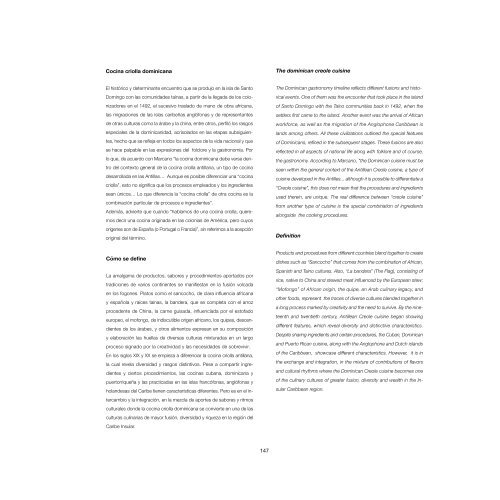Sabores-Ancestrales-Digital-1
You also want an ePaper? Increase the reach of your titles
YUMPU automatically turns print PDFs into web optimized ePapers that Google loves.
Cocina criolla dominicana<br />
The dominican creole cuisine<br />
El histórico y determinante encuentro que se produjo en la isla de Santo<br />
Domingo con las comunidades taínas, a partir de la llegada de los colonizadores<br />
en el 1492, el sucesivo traslado de mano de obra africana,<br />
las migraciones de las islas caribeñas anglófonas y de representantes<br />
de otras culturas como la árabe y la china, entre otros, perfiló los rasgos<br />
especiales de la dominicanidad, acrisolados en las etapas subsiguientes,<br />
hecho que se refleja en todos los aspectos de la vida nacional y que<br />
se hace palpable en las expresiones del folclore y la gastronomía. Por<br />
lo que, de acuerdo con Marcano “la cocina dominicana debe verse dentro<br />
del contexto general de la cocina criolla antillana, un tipo de cocina<br />
desarrollada en las Antillas… Aunque es posible diferenciar una “cocina<br />
criolla”, esto no significa que los procesos empleados y los ingredientes<br />
sean únicos… Lo que diferencia la “cocina criolla” de otra cocina es la<br />
combinación particular de procesos e ingredientes”.<br />
Además, advierte que cuando “hablamos de una cocina criolla, queremos<br />
decir una cocina originada en las colonias de América, pero cuyos<br />
orígenes son de España (o Portugal o Francia)”, sin referirnos a la acepción<br />
original del término.<br />
The Dominican gastronomy timeline reflects different fusions and historical<br />
events. One of them was the encounter that took place in the island<br />
of Santo Domingo with the Taíno communities back in 1492, when the<br />
settlers first came to the island. Another event was the arrival of African<br />
workforce, as well as the migration of the Anglophone Caribbean is<br />
lands among others. All these civilizations outlined the special features<br />
of Dominicans, refined in the subsequent stages. These fusions are also<br />
reflected in all aspects of national life along with folklore and of course,<br />
the gastronomy. According to Marcano, “the Dominican cuisine must be<br />
seen within the general context of the Antillean Creole cuisine, a type of<br />
cuisine developed in the Antilles... although it is possible to differentiate a<br />
“Creole cuisine”, this does not mean that the procedures and ingredients<br />
used therein, are unique. The real difference between “creole cuisine”<br />
from another type of cuisine is the special combination of ingredients<br />
alongside the cooking procedures.<br />
Definition<br />
Cómo se define<br />
La amalgama de productos, sabores y procedimientos aportados por<br />
tradiciones de varios continentes se manifiestan en la fusión volcada<br />
en los fogones. Platos como el sancocho, de clara influencia africana<br />
y española y raíces taínas, la bandera, que se completa con el arroz<br />
procedente de China, la carne guisada, influenciada por el estofado<br />
europeo, el mofongo, de indiscutible origen africano, los quipes, descendientes<br />
de los árabes, y otros alimentos expresan en su composición<br />
y elaboración las huellas de diversas culturas mixturadas en un largo<br />
proceso signado por la creatividad y las necesidades de sobrevivir.<br />
En los siglos XIX y XX se empieza a diferenciar la cocina criolla antillana,<br />
la cual revela diversidad y rasgos distintivos. Pese a compartir ingredientes<br />
y ciertos procedimientos, las cocinas cubana, dominicana y<br />
puertorriqueña y las practicadas en las islas francófonas, anglófonas y<br />
holandesas del Caribe tienen características diferentes. Pero es en el intercambio<br />
y la integración, en la mezcla de aportes de sabores y ritmos<br />
culturales donde la cocina criolla dominicana se convierte en una de las<br />
culturas culinarias de mayor fusión, diversidad y riqueza en la región del<br />
Caribe Insular.<br />
Products and procedures from different countries blend together to create<br />
dishes such as “Sancocho” that comes from the combination of African,<br />
Spanish and Taino cultures. Also, “La bandera” (The Flag), consisting of<br />
rice, native to China and stewed meat influenced by the European stew;<br />
“Mofongo” of African origin, the quipe, an Arab culinary legacy, and<br />
other foods, represent the traces of diverse cultures blended together in<br />
a long process marked by creativity and the need to survive. By the nineteenth<br />
and twentieth century, Antillean Creole cuisine began showing<br />
different features, which reveal diversity and distinctive characteristics.<br />
Despite sharing ingredients and certain procedures, the Cuban, Dominican<br />
and Puerto Rican cuisine, along with the Anglophone and Dutch islands<br />
of the Caribbean, showcase different characteristics. However, it is in<br />
the exchange and integration, in the mixture of contributions of flavors<br />
and cultural rhythms where the Dominican Creole cuisine becomes one<br />
of the culinary cultures of greater fusion, diversity and wealth in the Insular<br />
Caribbean region.<br />
147


